4 Classification of Surgical Cases
4.1 Principles of Surgical Classification
S. Chen, D. Buser, L. Cordaro
The application of the SAC Classification to surgical cases will follow the general guidelines outlined below. These guidelines will assist in generating the normative classification of a surgical case type. The influence of modifying factors on these case types will be discussed within this chapter.
The case types have been categorized into three groups. The first two groups are distinguished by whether the cases occur in sites of high or low esthetic risk. Within the two groups, cases are sub-categorized into single tooth replacements, short edentulous spaces of up to three teeth using two implants, extended edentulous spaces of more than three teeth in which three or more implants are to be used, and fully edentulous arches. The third group represents implants placed into sockets at the time of tooth extraction, also referred to as immediate implants, or Type 1 placement (Hämmerle et al. 2004). Implants placed into extraction sockets are characterized by specific hard and soft tissue factors, and have therefore been grouped separately.
4.1.1 General Criteria
Surgical cases may be classified as Straightforward, Advanced or Complex according to the following general criteria:
Straightforward
-
The surgical process is anticipated to be uncomplicated, with minimal surgical risk.
-
The anatomical risks are minimal.
-
Minimal post-operative complications are anticipated.
-
There is minimal esthetic risk.
Advanced
-
The surgical process is anticipated to be more demanding.
-
Proximity to important anatomical structures is likely to increase the difficulty of implant placement.
-
There is an increased risk of postoperative complications.
-
There is a moderate to high esthetic risk.
Complex
-
The surgical process is anticipated to be complicated.
-
Proximity to important anatomical structures heightens the difficulty and risk of implant placement.
-
Surgical demands on the clinician and ancillary staff are high.
-
There is a high risk of surgical complications.
-
There is a high esthetic risk.
4.1.2 Site-Specific Criteria
In addition to the general criteria above, the following site-specific factors were considered for each case type:
Bone volume. This relates to whether there is sufficient bone volume to place an implant or implants in the correct restoratively determined position, without the need for adjunctive augmentation procedures.
-
As a general principle, there should be a minimum oro-facial or horizontal bone dimension to maintain at least 1 mm of bone thickness on the facial and oral aspects (Buser et al. 2000). This minimum requirement is depicted in Figure 1.
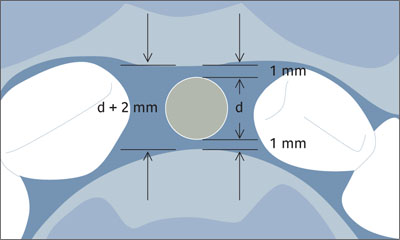
Figure 1. Schematic representation of the minimum oro-facial width of the bone required to place an implant. The oro-facial width of the bone should be at least 2 mm more than the core diameter of the implant (d + 2 mm, where d = diameter of implant). Provided that the implant is placed in the center of the ridge, this will provide at least 1 mm thickness of bone on the oral and facial aspects of the implant.
Core diameter of the implant + 2 mm (to provide 1mm thickness of facial and oral bone)
Taking into consideration the dimensional differences between commercially available implant systems, the following minimum horizontal bone dimensions are recommended (Table 1):
Table 1. Recommended Minimum Oro-facial or Horizontal Bone Width for Implants of Different Dimensions. Implant Size Core Diameter* Range (mm) Minimum Horizontal Bone Dimension (mm) Narrow diameter implants 3.0 to 3.5 5.0 to 5.5 Standard diameter implants 3.5 to 4.5 5.5 to 6.5 Wide diameter implants 4.5 to 6.0 6.5 to 8.0 * The table refers to the dimensions of the endosseous part of the implant and not the dimensions of the implant shoulder or restorative platform (which may vary depending upon the system and design of the implant).
The core diameter of the implant refers to the diameter of the body of the endosseous part of the implant, and excludes the outer dimensions of the implant threads (if present)
Narrow diameter implants (diameter range 3.0 to 3.5mm) – Horizontal bone dimension 5.0 to 5.5mm
Standard diameter implants (diameter range 3.5 to 4.5 mm) – Horizontal bone dimension 5.5 to 6.5mm
Wide diameter implants (diameter range 4.5 to 6.0mm) – Horizontal bone dimension 6.5 to 8.0mm
-
If the preoperative examination determines that the anticipated peri-implant defect will present with at least two bone walls, a simultaneous bone augmentation procedure may be carried out (Figures 2a and 2b). Care should be taken to ensure that the facial surface of the implant does not extend beyond the facial contour of the ridge (Figure 3). If this occurs, the demands on the surgeon to maintain space and to stabilize bone grafts and/or substitutes and barrier membranes increases.
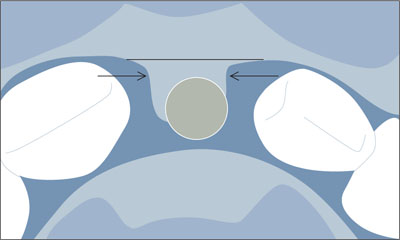
Figure 2a. If the anticipated bone defect has at least two intact bone walls (arrows) and the implant is placed within the confines of the ridge (outer limit of the ridge on the facial aspect is denoted by the line), then the defect is amenable to a bone augmentation procedure simultaneous with implant placement.
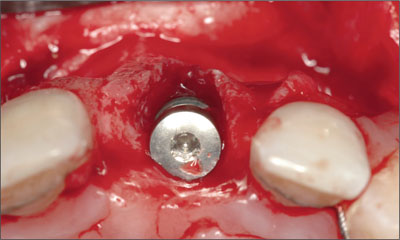
Figure 2b. Occlusal view of an implant in an extraction socket that has lost the facial bone wall. The residual defect has two bone walls remaining on the mesial and distal aspects. The implant is positioned well within the contour of the ridge. A simultaneous bone augmentation procedure may be carried out under these clinical conditions.
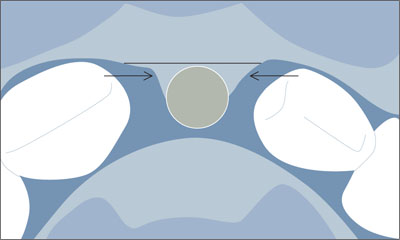
Figure 3. In this example, the bone defect presents with two intact bone walls (arrows). However, the implant is close to the facial limit of the alveolar ridge (line), as determined by the position of the intact bone on adjacent teeth. A simultaneous bone augmentation procedure may be considered; however, there will be greater demands on the surgeon to maintain space and to stabilize grafting materials and barrier membranes, and there is a risk of a less favorable regenerative outcome.
-
If the anticipated defect presents as a one-wall defect (Figure 4), a staged bone augmentation approach is recommended. Simultaneous grafting or ridge expansion techniques used for one-wall or no-wall defects should be regarded as Complex procedures.

Figure 4. If the anticipated bone defect has only one wall (arrow), then bone augmentation procedures simultaneous with implant placement are not predictable. In these situations, a staged approach is recommended, i.e., the ridge should be augmented as a first step and the implant placed some time later as a second procedure.
Anatomic risk. This relates to the likely involvement of adjacent roots, neurovascular structures, and the maxillary sinus or nasal cavity, and to perforation of the cortical bone. The anatomic risk at a donor site should also be considered.
Esthetic risk. This relates to the likelihood of pre-existing conditions or hard and soft tissue complications causing adverse esthetic outcomes. In sites of esthetic importance, there is an increased demand for adjunctive hard and soft tissue augmentation procedures and a high level of surgical skill to achieve predictable esthetic outcomes. Modifying factors for the esthetic risk include tissue biotype, lip line at smile, existing bone defects, and patient expectations. For the purpose of the classification, the regions of esthetic priority have been limited to maxillary anterior and premolars sites. It should be recognized that other sites may have esthetic importance depending upon the clinical case.
Complexity. This relates to the perceived difficulty of the planned surgical procedure. The difficulty of a surgical procedure is increased by:
-
Management of sites with minimal keratinized mucosa and vestibular depth.
-
Immediate placements or ridge preservation procedures.
-
Other interventions, including orthodontic tooth movement for site preparation, distraction osteogenesis, ridge splitting or expansion techniques, flapless procedures, and navigational surgery.
-
Adjunctive hard and soft tissue grafting procedures performed prior to or at the time of implant placement or as additional procedures after implants have been placed.
-
Extra-oral bone harvesting procedures which are considered Complex due to high surgical demands on the clinician and ancillary staff.
Complications. All surgical procedures carry a risk of complications with short- and long-term consequences.
Risk of complications: This refers to the likely risk of a complication as a result of the surgical procedure, including donor site morbidity. This also refers to the likely risk of the implant being incorrectly positioned due to pre-existing conditions, or hard and soft tissue complications.
Consequences of complications: The complication may have the following consequences:
-
The complication makes the surgical and subsequent restorative process more difficult, but does not have any effect on the outcome.
-
The complication results in a sub-optimal outcome which does not reduce the survival of the resulting restoration, but the result falls short of accepted ideals in one or more areas.
-
The complication compromises the outcome to a level where long-term success or stability of the implant and final restoration are diminished.
-
The complication jeopardizes the success of the whole procedure.
Implants in extraction sockets. Implants may be placed into extraction sockets at the time of tooth extraction (Type 1, or immediate placement) or following soft tissue healing (Type 2, or early placement).
Peri-implant defects with a horizontal component may be augmented as a simultaneous procedure if socket walls are intact or if only the facial wall has been damaged or lost. When two or more walls are missing or a vertical deficiency exists, a staged approach should be considered.
4.1.3 Classification Tables
The classification of surgical case types is presented in the following sections.
The normative classifications assigned refer only to standard presentations of the case type. As previously discussed, modifying factors may alter the normative classification and must be considered when making a final determination of the level of difficulty for the individual case. For the purpose of the classification and for simplification of the tables, esthetic sites are regarded as those in the anterior maxilla. Although upper posterior and all lower sites have been classified in the tables as non-esthetic regions, each case must be determined on its own merits depending upon the presentation of the case and the patient’s dental display during normal function and smiling.
It is not the purpose of this classification to list all the possible combinations of surgical procedures that may be required for a particular treatment. However, an indication is given of the types of adjunctive procedures that may be required.
4.2 Implants for Restoration of Single Tooth Spaces in Areas of Low Esthetic Risk
S. Chen
Table 1 represents the classification for implants in single tooth spaces in regions of low esthetic risk. In situations in which the anatomic risk is low and bone volume is sufficient to allow an implant to be placed in the correct restorative position, the level of difficulty and risk of complications is determined to be low. The normative classification is Straightforward.
| Areas of Low Esthetic Risk | Case Type: Single Tooth Space | |||||
| Risk Assessment | Normative Classification | Notes/ Adjunctive Procedures that may be required |
||||
| Bone Volume | Anatomic Risk | Esthetic Risk | Complexity | Risk of Complications | ||
| Defining Characteristics: One implant | ||||||
| Sufficient | Low | Low | Low | Low | Straightforward | |
| Deficient horizontally, allowing simultaneous augmentation | Low | Low | Moderate | Low | Advanced | Procedures for simultaneous horizontal bone augmentation
Low risk of complications for small defects, but risk may increase for larger defects Donor site morbidity |
| Deficient horizontally, requiring prior grafting | Low | Low | High | Moderate | Complex | Procedures for horizontal bone augmentation
Involvement of the mental foramina in the mandible Donor site morbidity |
| Deficient vertically | High | Low | High | High | Complex | Procedures for vertical and/or horizontal bone augmentation
Involvement of the mental foramina in the mandible Procedures for sinus floor grafting Risk to adjacent teeth with some vertical augmentation procedures Donor site morbidity |
When the bone is deficient horizontally but the site is amenable to an augmentation procedure at the time of implant placement, treatment will likely involve the need for bone grafts or substitutes and/or barrier membranes. These adjunctive techniques increase the degree of difficulty of the treatment, resulting in a normative classification of Advanced. It should be noted that the risk of complications may be low for small peri-implant defects, but increases with the size of the defect. If autogenous bone is harvested from a secondary site, donor site morbidity may be an additional complication.
If the site is deficient horizontally to a degree that bone augmentation is required prior to implant placement, the need for horizontal bone augmentation at sites with a lack of supporting bone walls significantly increases the level of difficulty of the treatment. Techniques for lateral bone augmentation may require combinations of autogenous bone grafts (block and/or particulate) or bone substitutes, tenting mechanisms for space maintenance, or barrier membranes (resorbable, non-resorbable and/or reinforced), depending upon operator preference. The level of difficulty is high, with a moderate risk of complications. The normative classification is Complex for this case type.
In situations in which there is a lack of sufficient bone height, either due to bone resorption or proximity to important anatomical structures, procedures for increasing the height of bone need to be undertaken. These procedures include onlay bone grafts, vertical guided bone regeneration (GBR), sinus floor augmentation, distraction osteogenesis, and nerve lateralization. In most cases, horizontal augmentation of the deficient site is needed. These procedures have a high level of difficulty and should only be performed by experienced surgeons. There is an elevated risk of involvement of important anatomical structures and of postoperative complications. For these reasons, the normative classification for this case type is Complex.
4.2.1 Clinical Case–Missing Lower Left Premolar and Molar
This is a case of a missing lower left second premolar (35) and first molar (36) in a healthy 28-year-old male patient (Figure 1). Although two teeth were missing, clinical examination showed 11 mm of mesio-distal space and 6 mm of vertical space from the mucosa to the opposing dentition. Slight supra-eruption of the upper left second pre-molar (25) was evident. The patient presented with good oral hygiene, and was dentally and periodontally healthy. A panoramic radiograph showed the presence of the mental foramen 12 to 14 mm from the crest of the ridge (Figure 2). A plain film tomographic view showed a ridge of 7 to 8 mm in horizontal dimension, and the presence of a minimal lingual concavity in the mandible (Figure 3). The treatment plan was to place a single wide-diameter implant to support a single crown.
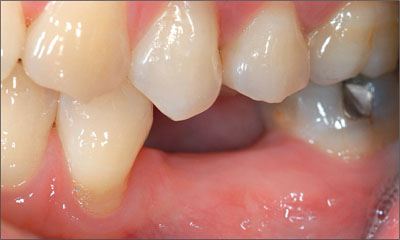
Figure 1. Facial view of missing lower left first molar (tooth 36) showing sufficient mesio-distal space and adequate vertical clearance for implant therapy.
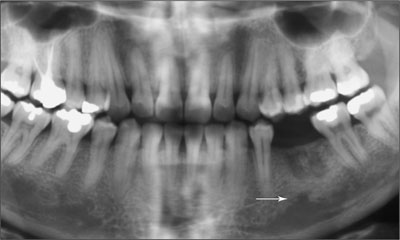
Figure 2. Panoramic radiograph showing the 35, 36 site, with sufficient vertical bone height superior to the mandibular canal. Note the location of the mental foramen (arrow).
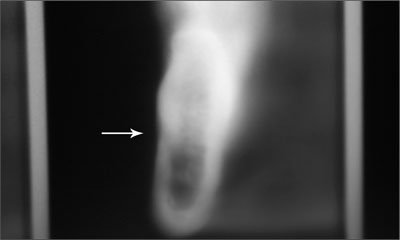
Figure 3. Plain-film tomogram of the 35, 36 site showing sufficient horizontal bone width and a minimal lingual concavity of the ridge. Note the position of the mental foramen (arrow).
The bone volume was sufficient to place an implant with minimal anatomic risk. The procedure was determined to have a relatively low level of difficulty, with a low risk of operative and postoperative complications. The surgical SAC Classification was therefore determined to be Straightforward (Table 2).
| General Factors | Assessment | Notes |
| Medical contraindications | None | |
| Smoking habit | None | |
| Growth considerations | None | |
| Site Factors | Assessment | Notes |
| Bone volume | Sufficient | |
| Anatomic risk | Low | Mental foramen 12 to 14 mm from ridge crest Minimal risk of perforating the lingual cortex |
| Esthetic risk | Low | |
| Complexity | Low | Sufficient mouth-opening to provide adequate surgical access Sufficient bone volume to allow implant placement without the need for adjunctive bone augmentation procedures. |
| Risk of complications | Low | Risk of complications will be low with insertion of an implant 10 mm in length |
| Loading protocol | Early | The plan was to restore the implant 6 to 8 weeks after placement |
| SAC Classification | Straightforward |
Following reflection of full-thickness facial and oral flaps, the ridge was exposed and the horizontal width of bone was confirmed (Figure 4). The facial and oral surfaces of the ridge were explored to confirm that there were no defects or concavities. A 10 mm Straumann SLA implant (Straumann Implant System, Straumann AG, Basel, Switzerland) with a wide neck (6.5 mm) and 4.8 mm body was placed (Figure 5). A bone wall thickness of 1 mm was maintained on both the facial and oral surfaces of the implant. A healing cap was then attached to the implant and the flaps were closed with interrupted sutures (Figure 6). Six weeks later, the implant had successfully integrated (Figures 7 and 8) and was subsequently restored with a cement-retained PFM crown.
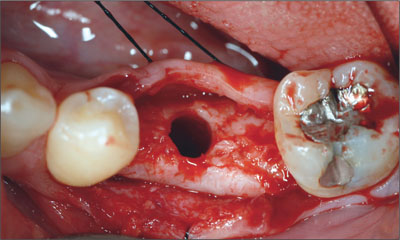
Figure 4. Intra-operative view of the osteotomy, showing maintenance of sufficient thickness of the facial and oral bone walls.
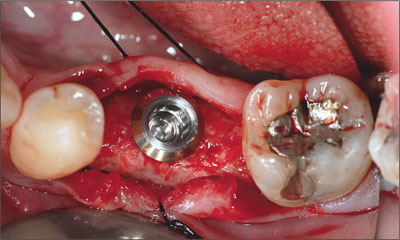
Figure 5. Intra-operative view of the implant in place.
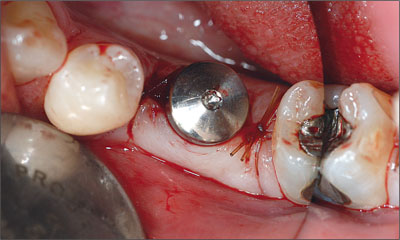
Figure 6. A healing cap was attached to the implant and the flaps were closed with interrupted sutures.
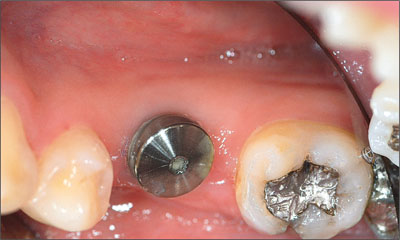
Figure 7. Clinical situation after six weeks of healing. The implant had successfully integrated.
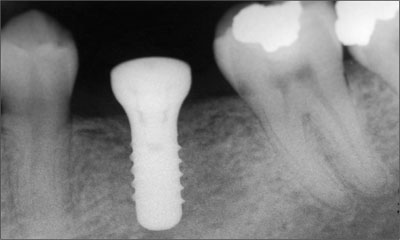
Figure 8. Periapical radiograph of the implant six weeks after placement.
4.3 Implants for Restoration of Short Edentulous Spaces in Areas of Low Esthetic Risk
D. Buser
Table 1 summarizes the classification for the surgical placement of implants in short edentulous spaces in areas of low esthetic risk. These cases will be limited to the replacement of up to three teeth supported by one or two implants. When the anatomic risk is low and bone volume is sufficient to allow implants to be placed in the correct restorative position, the level of difficulty and risk of complications is low. The normative classification is Straightforward.
| Areas of Low Esthetic Risk | Case Type: Short Edentulous Space | |||||
| Risk Assessment | Normative Classification | Notes/ Adjunctive Procedures that may be required |
||||
| Bone Volume | Anatomic Risk | Esthetic Risk | Complexity | Risk of Complications | ||
| Defining Characteristics: Two implants and up to 3 teeth replaced | ||||||
| Sufficient | Low | Low | Low | Low | Straightforward | |
| Deficient horizontally, allowing simultaneous grafting | Low | Low | Moderate | Moderate | Advanced | Procedures for simultaneous horizontal bone augmentation
Low risk of complications for small defects, but risk may increase for larger defects Donor site morbidity |
| Deficient horizontally, requiring prior grafting | Low | Low | High | Moderate | Complex | Procedures for horizontal bone augmentation
Involvement of the mental foramina in the mandible Donor site morbidity |
| Deficient vertically and/or horizontally | High | Low | High | High | Complex | Procedures for vertical and/or horizontal bone augmentation
Involvement of the mental foramina in the mandible Procedures for sinus floor grafting Risk to adjacent teeth with some vertical augmentation procedures Donor site morbidity |
When the bone is deficient horizontally but the defect allows implant placement with a simultaneous bone augmentation procedure, treatment will usually involve the need for bone grafts or substitutes and/or barrier membranes. These additional procedures increase the degree of difficulty of the treatment, and are assigned a normative classification of Advanced. Although the risk of complications may be low for small peri-implant defects, the risk increases correspondingly with an increase in the size of the defect. If autogenous bone is harvested from a secondary site, donor site morbidity may be an additional complication.
If the site is deficient horizontally and the peri-implant defect is expected to have fewer than two intact bone walls, a staged approach is strongly recommended. The need for horizontal bone augmentation at sites with a lack of supporting bone walls significantly increases the level of difficulty for the surgeon. Techniques for horizontal bone augmentation may require various combinations of autogenous bone grafts or bone substitutes, tenting mechanisms for space maintenance, and barrier membranes, depending upon the clinical indication and the surgeon’s preference. These procedures require the surgeon to be well-trained and experienced. Implants can only be placed following a successful outcome with the initial augmentation procedure. The level of difficulty is therefore regarded as high, with a moderate risk of complications. The normative classification is Complex for this case type.
At sites that lack sufficient bone height either due to resorptive processes or due to proximity to important anatomical structures, procedures for increasing the height of bone need to be undertaken. These procedures include onlay bone grafts and vertical guided bone regeneration. In most cases, there is a concomitant need for horizontal augmentation of the deficient site. These procedures have a high level of difficulty and carry a high risk of involvement of important anatomical structures and of postoperative complications. The normative classification is Complex.
4.3.1 Clinical Case–Missing Lower Left Premolar and Molar
A female patient presented with a loss of retention of a short-span, three-unit fixed dental prosthesis (FDP) in the left mandible due to caries that had undermined the retainer attached to the second premolar. The clinical examination revealed that the root of tooth 35 could not be maintained and had to be removed (Figure 1). In the first molar site, the bone crest was clearly reduced in horizontal width due to non-functional atrophy. The panoramic radiograph showed sufficient bone height in general in the left mandible (Figure 2). The mental foramen was located slightly distal to the apex of tooth 35. Tooth 37 was clearly tilted mesially and exhibited radiolucency on the mesial aspect. The patient expressed a desire to restore the occlusion in the left mandible with a fixed restoration, if possible without a staged approach. The treatment plan was to extract the roots of tooth 35 and tooth 37, and to use the concept of early implant placement to keep the risk of complications low. Implants would be placed in the 35 and 37 sites with simultaneous GBR. The implants would support a three-unit FDP.
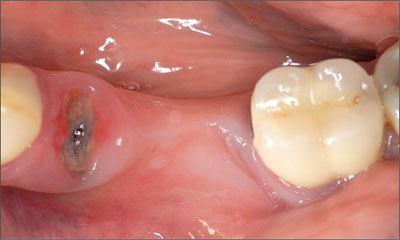
Figure 1. Occlusal view of the case showing the root of tooth 35.
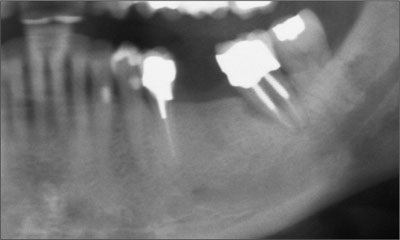
Figure 2. Panoramic radiograph of the lower left quadrant.
The preoperative assessment indicated that there was sufficient bone width and height in both the proposed implant sites (35 and 37). However, an extraction socket defect was anticipated in the 35 site, with possible damage to the facial bone wall. The anatomic risk was low, but care would need to be taken at the time of surgery to avoid injury to the mental nerve. The level of difficulty was determined to be high due to the need for a simultaneous GBR procedure with primary wound closure. The risk of complications with the GBR procedure was regarded as low. The risk of damage to the mental nerve was also judged to be low with careful flap elevation and protection of the mental nerve throughout the procedure. The surgical SAC Classification was determined to be Advanced (Table 2).
| General Factors | Assessment | Notes |
| Medical contraindications | None | |
| Smoking habit | None | |
| Growth considerations | None | |
| Site Factors | Assessment | Notes |
| Bone volume in sites 35 and 37 | Sufficient in width, but extraction socket defect in area 35 | Two-wall defect in area 35 Standard placement in area 37 |
| Anatomic risk | Low | Mental foramen is located in between the two future implant positions |
| Esthetic risk | Low | |
| Complexity | Moderate | Simultaneous GBR procedure for implant 35 |
| Risk of complications | Low | Risk of complications will be low with simultaneous GBR procedure Mental nerve may be involved with flap reflection and needs to be protected throughout the procedure |
| Loading protocol | Early | |
| SAC Classification | Advanced |
The roots of teeth 35 and 37 were then extracted (Figure 3). Following a soft tissue healing period of 6 weeks (Figure 4), implant placement was planned for the extraction socket defect in area 35 and slightly mesial to the extraction socket defect in area 37 (Figure 5). It was anticipated that the 35 site would have a defect on the facial aspect, with two intact bone walls. Thus implant placement with a simultaneous GBR procedure was possible in this site, which was given a normative classification of Advanced. In area 37, standard implant placement was possible with non-submerged healing (Figure 6). Following an uneventful healing period of 8 weeks, the 35 implant was exposed with a punch technique and a healing cap was attached. Restorative procedures commenced soon after this, and two weeks later an implant-borne three-unit FDP was inserted (Figure 7 and 8).
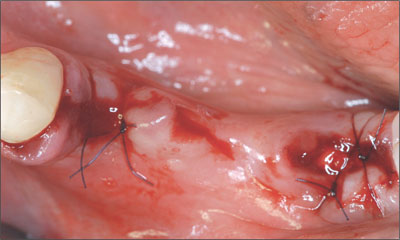
Figure 3. Occlusal view of the surgical sites immediately following extraction of the roots of tooth 35 and tooth 37.
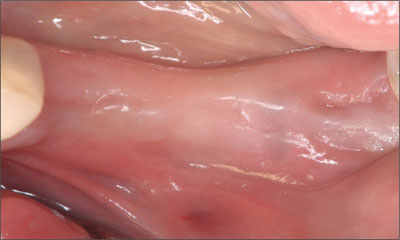
Figure 4. Occlusal view of the ridge six weeks following extraction of the teeth.
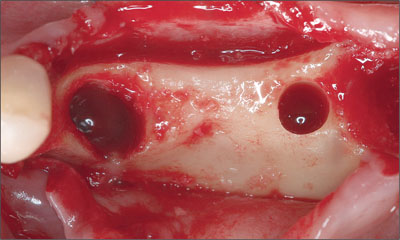
Figure 5. Following flap reflection, the 35 socket was evident. The distal osteotomy was prepared slightly mesial to the 37 socket.
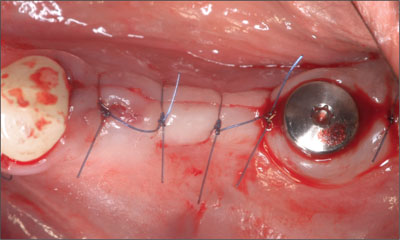
Figure 6. A simultaneous implant placement and GBR procedure was performed in the 35 site, with primary closure of the flap. In the 37 site, standard placement was performed using a non-submerged healing protocol.
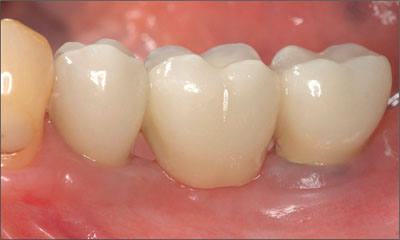
Figure 7. Facial view of the implant-borne three-unit FDP.
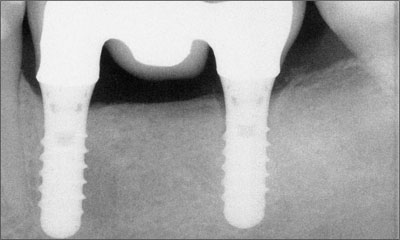
Figure 8. Radiographic view of the implants and completed FDP.
4.4 Implants for Restoration of Extended Edentulous Spaces in Areas of Low Esthetic Risk
L. Cordaro
Table 1 outlines the classification for implant surgical procedures aimed to restore extended edentulous spaces in regions of low esthetic risk. An extended edentulous space is defined as a site where more than three teeth are missing and more than two implants are needed to support a FDP. In situations in which the anatomic and esthetic risks are low and bone volume is sufficient to allow implants of appropriate dimensions to be placed in the correct restorative position, the procedure is considered to be Straightforward. The level of complexity is deemed to be moderate due to the increased number of implants placed and demands on the surgeon to maintain a proper relative alignment and position of the implants. The risk of complications is regarded as low.
| Areas of Low Esthetic Risk | Case Type: Extended Edentulous Space | |||||
| Risk Assessment | Normative Classification | Notes/ Adjunctive Procedures that may be required |
||||
| Bone Volume | Anatomic Risk | Esthetic Risk | Complexity | Risk of Complications | ||
| Defining Characteristics: More than 2 implants, span of more than 3 teeth | ||||||
| Sufficient | Low | Low | Moderate | Low | Straightforward | None |
| Deficient horizontally, allowing simultaneous grafting | Moderate | Low | Moderate | Moderate | Advanced | Procedures for simultaneous horizontal bone augmentation
Low risk of complications for small defects, but risk may increase for larger defects Involvement of the mental foramina in the mandible Donor site morbidity |
| Deficient horizontally, requiring prior grafting | Moderate | Low | High | Moderate | Complex | Procedures for horizontal bone augmentation
Involvement of the mental foramina in the mandible Donor site morbidity |
| Deficient vertically, with or without a horizontal defect | High | Low | High | High | Complex | Risk to adjacent teeth
Procedures for vertical and/or horizontal bone augmentation Involvement of the mental foramen and inferior alveolar nerve in the mandible Procedures for sinus floor grafting Donor site morbidity |
When a similar situation involves an alveolar segment with reduced bone width that can be augmented at the time of implant placement, the normative classification is Advanced. Both the anatomical and surgical risks are moderate due to the bone augmentation procedures needed at the time of implant placement. These procedures usually involve the use of grafts with autogenous bone or bone substitutes that may require protection during healing with either resorbable or non-resorbable membranes. The esthetic risk is low and the complexity is moderate.
A different normative classification is assigned to extended edentulous spans in non-esthetic sites when the horizontal bone deficiency needs to be corrected before implant placement in a separate surgical procedure. Reconstructive procedures include block bone grafts or guided bone regeneration with combinations of autogenous bone or bone substitutes and resorbable, non-resorbable, or reinforced barrier membranes. The complexity of the procedure is high due to the increased demands on the surgeon and the need for multiple surgical procedures. It should be noted that the possibility of placing implants in a second procedure is contingent upon successful horizontal augmentation of the ridge in the first instance. If the outcome of bone augmentation is sub-optimal, the subsequent implant placements may be compromised. The esthetic risk is low but the anatomical risk and the risk of complications are moderate. This case type has a normative classification of Complex.
In cases that show a vertical alveolar deficiency with or without an associated horizontal defect, the surgical procedure should be considered Complex. In these cases, the need for very demanding reconstructive procedures prior to or at the time of implant placement is usually associated with a high anatomical risk and a high risk of complications and failures. These factors increase the complexity of the procedure to a high level. When a vertical augmentation is needed in mandibular posterior sites, the procedure must be considered very challenging, even for the very experienced surgeon.
4.4.1 Clinical Case – Four Missing Posterior Teeth in the Upper Left Quadrant
A 58-year-old woman with an extended edentulous space in the upper left quadrant requested a fixed rehabilitation (Figure 1). No general health problems were present, and acceptable oral hygiene was maintained. An anterior open bite was evident and a noticeable functional impairment was present. Panoramic and intra-oral radiographs demonstrated reduced bone height in the region of the first and second molars (Figures 2 and 3). The treatment plan was to augment the height of bone in the posterior maxilla by elevating the floor of the maxillary sinus and placing a synthetic bone graft. Following maturation of the graft, it was planned to insert three implants to support a four-unit FDP. Implants were planned to be placed in the first premolar and first and second molar sites. In this way, no cantilever units would be included in the prosthesis, and a better esthetic result was anticipated at the premolar sites by avoiding adjacent implants.
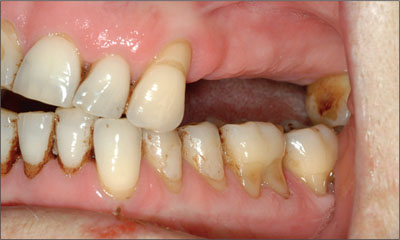
Figure 1. Intraoral view of the extended edentulous space in the upper left posterior sextant. Teeth 24, 25, 26 and 27 were missing.
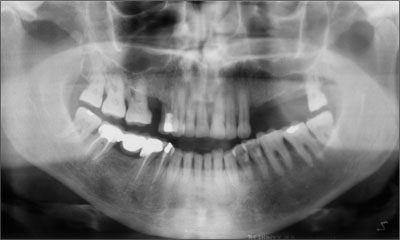
Figure 2. Panoramic radiograph of the case, showing missing teeth in the upper left posterior sextant.
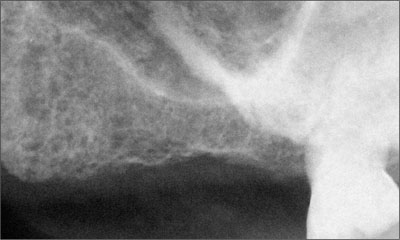
Figure 3. An intraoral radiograph demonstrating reduced bone height in the first and second molar sites.
The pre-operative assessment confirmed sufficient horizontal bone dimension but reduced vertical bone dimension in the molar region. Due to involvement of the maxillary sinus, the anatomic risk was high. The esthetic risk was assessed to be moderate, as the upper premolar teeth were visible in the patient’s smile. As multiple procedures were planned and surgical technical demands associated with the augmentation of the sinus floor were significant, the level of complexity was regarded as high. However, through staging of the treatment, any complications associated with the sinus floor augmentation procedure would be independent of the implants subsequently placed. Thus, the risk of complications and the sequelae of any complications were regarded as only moderate. The surgical SAC Classification was assessed as Complex (Table 2).
| General Factors | Assessment | Notes |
| Medical contraindications | None | |
| Smoking habit | None | |
| Growth considerations | None | |
| Site Factors | Assessment | Notes |
| Bone volume | Adequate in width | Vertical deficiency in the first and second molar sites Sinus floor augmentation required |
| Anatomic risk | High | Involvement of the maxillary sinus |
| Esthetic risk | Moderate | Posterior edentulous space Upper premolar teeth visible in the patient’s smile. |
| Complexity | High | A staged approach is required. Technical demands associated with the sinus augmentation procedure Implants may only be placed in the molar sites following a successful outcome of the initial sinus augmentation procedure. |
| Risk of complications | Moderate | Risk of perioperative and postoperative complications associated with the sinus floor augmentation procedure |
| Loading protocol | Early | |
| SAC Classification | Complex |
Augmentation of the floor of the sinus was planned with a synthetic bone substitute to avoid the need for harvesting autogenous bone. Since only the reconstructive phase was planned during the first surgical step, access to the lateral sinus wall was obtained following elevation of a mucoperiosteal flap with vertical releasing incisions that did not involve the marginal tissues of the canine. Once the elevation of the sinus mucosa was performed, a biphasic calcium phosphate material (Straumann Bone Ceramic, Straumann AG, Basel, Switzerland) was applied in the defect as an inlay graft (Figures 4 to 6). Four months later, two wide-body SLActive implants (Straumann Implant System, Straumann AG, Basel, Switzerland) with a 4.8 mm diameter of the neck and of the implant body were inserted in the molar sites. One standard SLActive implant was inserted in the region of the first premolar (Figures 7 and 8). All implants were 10 mm in length. Implant location and axial orientation were verified with a surgical stent. After four months the implants were restored with a four-unit porcelain-fused-to-metal FDP. The occlusal view shows the reduced oro-facial dimensions of the prosthesis (Figures 9 and 10). The final radiographs demonstrate the effective reconstruction of the deficient ridge and stable marginal bone levels (Figures 11 and 12).
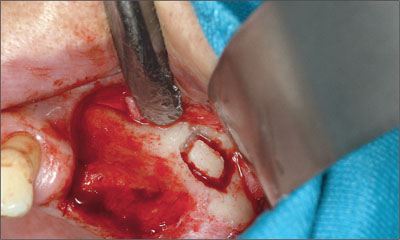
Figure 4. Intraoperative view of the facial surface of the alveolar bone and the outline of the window into the maxillary sinus.
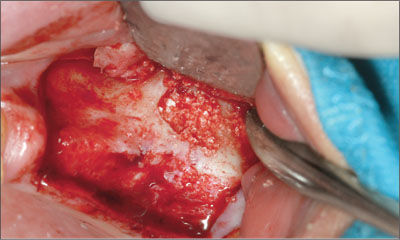
Figure 5. Intraoperative view of the lateral window following placement of the graft.
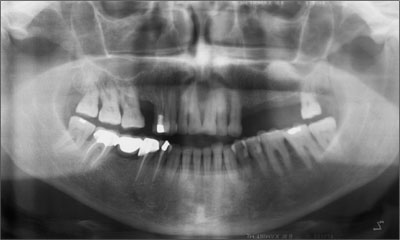
Figure 6. Panoramic view of the patient’s dentition showing the upper left posterior sextant after sinus floor elevation.
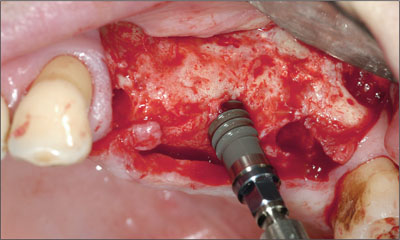
Figure 7. Surgical re-entry was performed four months later. The intraoperative view shows the three osteotomy sites and an implant being inserted in the 26 site.
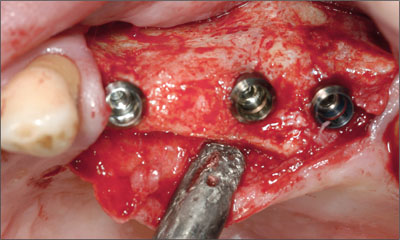
Figure 8. The intraoperative occlusal view shows adequate bone width. The three implants were installed in the planned locations.
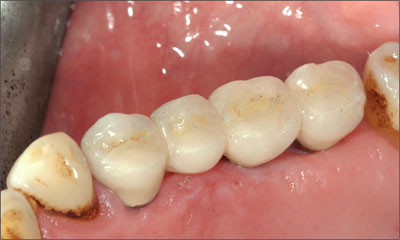
Figure 9. Intraoral occlusal view of the completed four-unit FDP.
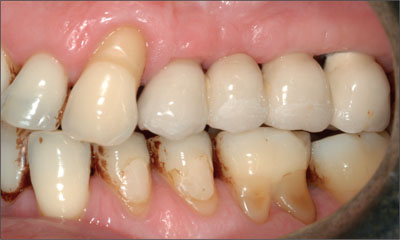
Figure 10. Intraoral facial view of the completed four-unit FDP.
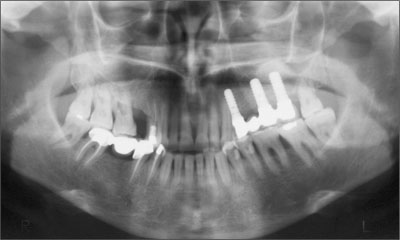
Figure 11. Panoramic radiograph of the completed case.
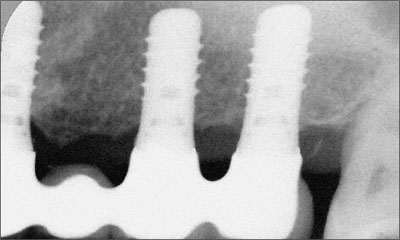
Figure 12. Periapical radiograph of the completed case, showing stable crestal bone.
4.5 Implants for an Implant-supported Denture or a Full-arch Fixed Dental Prosthesis in the Edentulous Mandible
D. Buser
Table 1 represents the classification for implant procedures in the edentulous mandible, which in most cases represents an indication for implant therapy with low esthetic risk.
| Areas of Low Esthetic Risk | Case Type: Full Arch – Mandible | |||||
| Risk Assessment | Normative Classification | Notes/ Adjunctive Procedures that may be required |
||||
| Bone Volume | Anatomic Risk | Esthetic Risk | Complexity | Risk of Complications | ||
| Defining Characteristics: 2 implants, interforaminal region | ||||||
| Sufficient | Low | Low | Low | Low | Straightforward | None |
| Deficient, but allowing simultaneous bone augmentation | Moderate | Low | Moderate | Moderate | Advanced | Risk of perforation of lingual cortex Procedures for simultaneous horizontal bone augmentation |
| Defining Characteristics: 3 or 4 implants, interforaminal region | ||||||
| Sufficient | Moderate | Low | Moderate | Moderate | Advanced | Involvement of the mental foramina |
| Deficient, but allowing simultaneous or prior bone augmentation | Moderate | Low | High | High | Complex | Risk of mental nerve involvement Risk of perforation of lingual cortex Procedures for simultaneous or prior horizontal bone augmentation |
| Defining Characteristics: > 4 implants, extending distal to interforaminal region | ||||||
| Sufficient both in vertical and horizontal dimensions | Moderate | Low | Moderate | Moderate | Advanced | Involvement of the mental fo/> |
Stay updated, free dental videos. Join our Telegram channel

VIDEdental - Online dental courses


